Plant propagation
If the peduncles are not removed, after they dry out, daughter rosettes appear, - thus, the young reproduce independently in nature.
Gardeners distinguish two main methods of reproduction: seeds and shoots - rosettes.
Seed.
Initially, it is important to note that this method is laborious and time-consuming. Energy costs will be justified only if a new variety is developed
So, after collecting ripe seeds, they are sown in a separate container. Suitable soil intended for planting cacti, enriched with peat and limestone, loose and not dense. It is necessary to sow almost on the surface of the moistened soil, slightly embedding them in the ground (no more than 1 mm). This is most often done in early spring.
For seed germination, provide a bright place and a temperature of at least 20 ° C. Not desirable, direct contact with young, sunlight.
When shoots appear, you need to moisten the soil. An excess of moisture is detrimental to the succulent, but for the growth of seedlings, regular, but not abundant watering is needed.
After about 2 months, you need to dive the seedlings. And, by the middle of summer, planting in open ground is possible. When planting, maintain a distance between crops - at least 10 cm.
Vegetative.
This is the most common and easy breeding method - through daughter outlets. Rejuvenated independently reproduces in this way. But, in order to streamline the flower beds, it is better to control this process.
The emerging "babies" are kept on strong stalks and are associated with the mother plant. But, as soon as they grow to the surface of the soil, they will immediately begin to take root. Over time, the main plant is densely surrounded by such "children". The daughter sockets have their own roots almost immediately. Then, they are easily separated from the adult plant and planted in a flower bed.
It is better to plant outlets in spring or summer.
When choosing shoots, you need to pay attention to larger, grown (with roots) specimens of sockets. If you do not separate the daughter rosettes from the adult plant, a solid, beautiful carpet will soon form.
This property is used by flower growers, using rejuvenated as a ground cover plant.
You can plant and transplant a stone rose throughout the growing season. The plant easily takes root in a new place and soon begins to delight the eye with numerous offspring.
Care for the young
Rejuvenated, perhaps, the strangest and unpretentious plant among horticultural crops. Many people know this plant under the name "hare cabbage" or "stone rose", because the young prefers to grow on rocky areas, rock gardens. You can often find rejuvenated in perennial beds, on balconies. Very often, decorative objects are used to grow it, for example, a shoe or a beautiful jug. You can grow a real multi-colored carpet from the rosettes of the young.
Homeland and appearance of the plant
The homeland of the plant is Southern and Central Europe. In this area, rejuvenation grows in dry, rocky areas. That is why today it was rejuvenated - a real decoration of rock gardens and dry walls.
The diameter of the rosettes varies from half a centimeter to six centimeters. If the varieties are selective, the diameter may be larger.
The color palette of the leaves can be very diverse: from simple green to rich purple. There are types of rejuvenated with two-colored leaves, in this case the upper part of the leaves has a contrasting shade. In many varieties, the color of the leaves changes throughout the year.However, the change in the shade of the leaves is associated not only with the season, but also with the growing conditions. The sunnier the area, the brighter and richer the color of the leaves. One outlet contains from 30 to 70 leaves.
In the second half of May or early June, inflorescences appear, but only on old rosettes. The flowers are star-shaped in pink, white, red or yellow.
The main principles of caring for the young are the timely removal of weeds, dry inflorescences.
Watering mode
In general, the young are adapted to growing in any, even the most extreme conditions. The vast majority of rejuvenated species grow easily in both hot and cold climates. However, you should protect the plant from excess moisture, as the rosette may die. If the young grows on poor soil, watering should be more abundant. The best way to protect the plant from excess moisture is to provide a drainage layer when planting.
The most drought-resistant species of juveniles are strongly pubescent varieties.
Fertilizers and feeding
In the case of juveniles, the following principle applies: the more nutrients in the soil, the paler the color of the rosettes will become, although their size will increase. In addition, an excess of nutrients reduces the frost resistance of the flower. As for the acidity of the soil, it should be neutral or alkaline.
Priming
Any soil composition is suitable for rejuvenation, with the exception of damp ones. It is better to give preference to dry, sandy soils. To loosen the soil, fine granite, coarse sand or expanded clay can be added to it.
How to propagate a young man?
Reproduction of rejuvenated can be done in several ways:
- seed;
- cuttings;
- children.
The seed method can be classified as complex, but there are gardeners who are much more interested in getting a plant from seeds and personally seeing its development than buying a ready-made adult plant. Therefore, if there is a desire to grow young from seeds, this is great, the main thing is to follow all the rules in order to get a beautiful plant.
Cutting is much easier, you need moistened sand or other soil, transparent material and charcoal (activated or woody). After the roots appear, the cuttings are planted in a permanent place of growth. But it is more expedient and much more effective to reproduce by children, which does not cause difficulties.
Rejuvenated - seed reproduction
You can start growing young from seeds already in February. Drainage holes are made in plastic pots, sandy soil is poured (if transplanting into open ground is planned), if the plants remain indoors, a mixture for cacti is used. The soil is watered or sprayed from a spray bottle, seeds are laid out on its surface, slightly pressing them.
The soil temperature is maintained at 20 degrees, the seedlings are placed in a place with good lighting. The sprouts appear in about 5-6 days. Watering is rare enough, once every 3-4 weeks. Watering should be done so that no water gets into the leaf axils. In a permanent place, seedlings can be planted closer to the middle of summer.
How to propagate young children?
Reproduction by young children allows you to preserve maternal traits in young plants. For the reproduction process, the lateral shoots are separated from the mother plant. This is done with a sharp knife or hands. The baby is placed in a substrate; treatment with a root formation stimulator can be carried out. Then the children are provided with sunlight and an air temperature of + 22 + 25 ° C. This is the best mode for growing roots by children.
In some species of young, buds are formed, from which shoots extend in different directions. These shoots are separated and planted in moist soil. On average, the rooting of shoots takes a month, but depending on the variety, the rooting time may differ. You can root it at any time of the year (except for winter), because the plant is very unpretentious.
How to propagate a young leaf?
Reproduction with a young leaf is theoretically possible, but few growers succeed in this. The technique is troublesome, the leaves often rot and die. The cut sheet is dried for several days, planted in a mixture of peat and sand and covered with a plastic bag. It also happens that the leaf dies before the roots appear. Therefore, flower growers prefer other methods.
It was rejuvenated - planting and care in the open field does not give the grower any special problems and anxiety, but it gives the opportunity to admire the unusual beauty. The flower is amazing, decorates any garden area. The plant is also unique in that it accumulates water in its leaves and uses it at the right time for itself.
Features of agricultural technology for growing a plant
When you look at the young, it seems that it is incredibly difficult to breed this plant - it looks so bizarre. However, this unpretentious plant was rejuvenated, and it almost does not require maintenance, but still there are some nuances of its cultivation.
Landing
When planting a plant, some points are important:
He needs poor, but not acidic soil, but well-drained. On nutrient soil, the rosettes grow large, but the plant may not overwinter. And there is a loss of varietal traits.
For better growth and development, sand, expanded clay or granite screenings are added to the soil.
On clay and heavy soils, oversaturated with fertilizers, the flower does not develop well.
- With an abundance of summer rains and dew, the plant is not watered, however, with a dry summer, watering is necessary. In the absence of the proper amount of moisture, the leaves dry out and curl;
- The best place for a flower is sunny, but it can also grow in the shade. However, the rosette collapses and pallor is observed in the color of the leaves.
- With high humidity, the plant is affected by rot. The leaves become transparent and turn brown in the last stage.
It is important to know that rot does not spread to adjacent outlets. Control measures in this case are simple: it is necessary to remove the affected rosettes or lower leaves at the initial stage.
When planting large specimens, the distance is taken into account. It is 10-15 cm, between small species 6-8 cm. Daughter rosettes will cover the entire surface;
It is important to know that some species give arrows with children from the lower axils of the leaves, and others from both the lower and upper ones. The plant has small roots, so when planting, do not make large indentations.
The plant has small roots, so when planting, do not make large indentations.
Signs and popular beliefs about the youth
- One of the most ancient signs is that the plant was considered the protector of the house from many diseases and promised wealth and prosperity to its owners. Plants covering the roofs of dwellings have been called roofing youth since ancient times.
- If people believe in superstition, then I would like to say that many call the plant graveyard. But this is just superstition, because in the modern world, the "stone rose" looks great both in the office space, as well as on the windowsills of houses and apartments.
- It was rejuvenated even applicable to wedding bouquets, and everyone prepares carefully and deliberately for such an event. And if someone likes this plant, there is no need to be afraid of superstitions and accepts, but you can safely take on its cultivation and cultivation. After all, flowers very strongly absorb the surrounding energy field and can both negatively and positively affect a person.
- There are superstitions among the people that if you want a plant to grow better, then it must be stolen. And if this happened, then it is best to leave a coin instead.
- Giving a flower in a pot is a bad omen, since together with the flower, a person receives the energy of the former owner, and it may not always be good. If the donor is given a coin in return, then the flower will decide that it was bought and has a new owner.
Recommended species and varieties
S. andrecmum (M. Andre)
Rosettes of bright green leaves with brown tips form small clumps. The diameter of the leaf rosettes is up to 4 cm.Pink flowers sit on stems about 15 cm high.The height and diameter of the plant is 2.5x20 cm.
 Rosettes of bright green leaves
Rosettes of bright green leaves
Arachnoideum (M. cobweb)
Light green spherical rosettes of leaves do not exceed 2 cm in diameter and are covered with a web of white hairs. The rosettes form low dense rugs. Pinkish-red flowers are formed on peduncles 12.5 cm high.The height and diameter of the plant is 2.5x20 cm.
 Light green ball-shaped rosettes
Light green ball-shaped rosettes
Leaves of a variety with a raspberry tint.
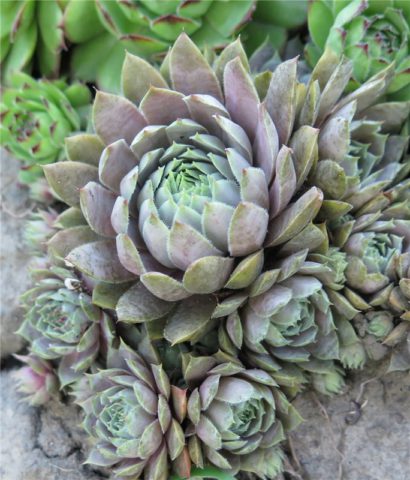 "Stansfieldh"
"Stansfieldh"
Leaves have a thicker web of hairs and form larger rosettes.
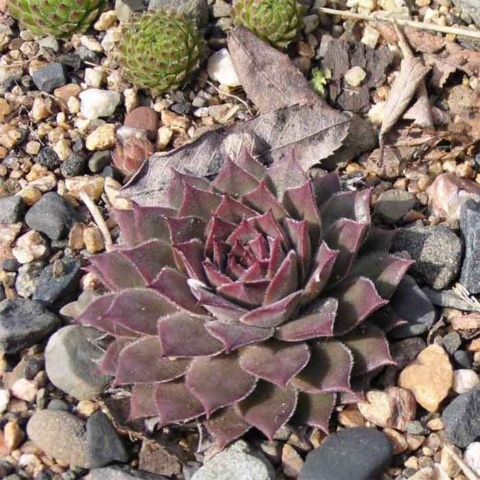 Ssp. tomentosum
Ssp. tomentosum
Calcareum (M. calcareous)
A very variable species, usually forming leafy rosettes with a diameter of 7.5 cm. There are purple-brown spots on the tips of the bluish-green leaves. Pale pink flowers bloom at the tops of peduncles up to 25 cm high.The height and diameter of the plant is 5x30 cm.
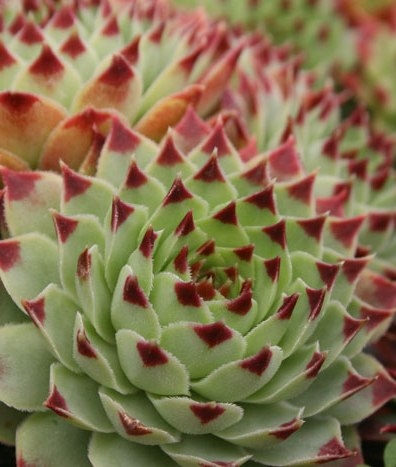 Changeable view
Changeable view
The diameter of the leaf rosettes of the variety does not exceed 4 cm.
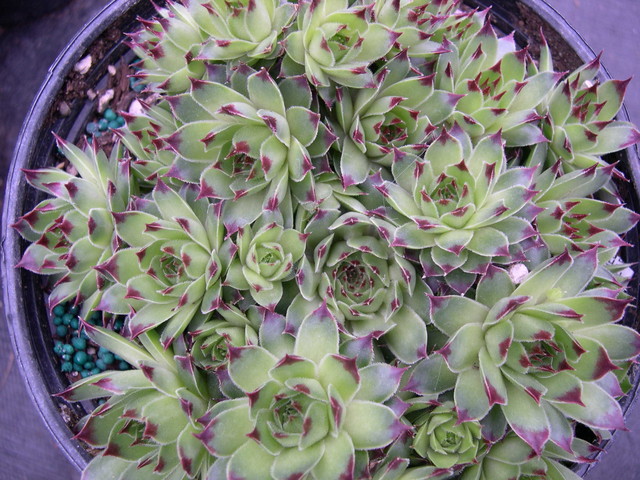 "Greenii"
"Greenii"
S. ciliosum (M. ciliate)
The species is valued mainly for the perfectly spherical shape of grayish-green leafy rosettes up to 5 cm in diameter. In summer, peduncles up to 10 cm in height with inflorescences of lemon-yellow flowers rise above the clumps of rosettes. The height and diameter of the plant is 5x25 cm.
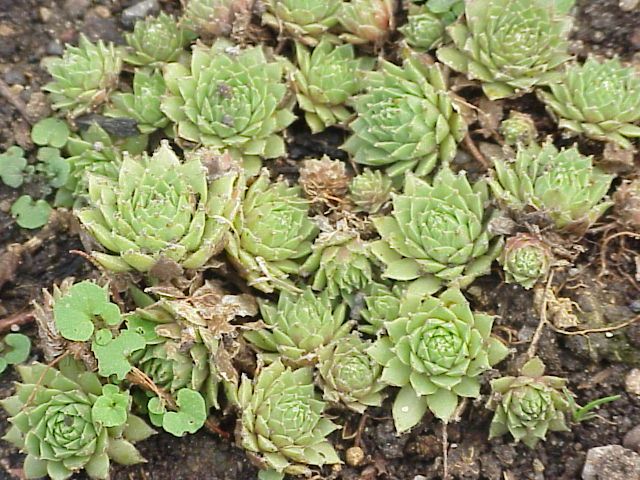 Spherical shape
Spherical shape
The leaves of the variety take on an attractive red hue in full sun.
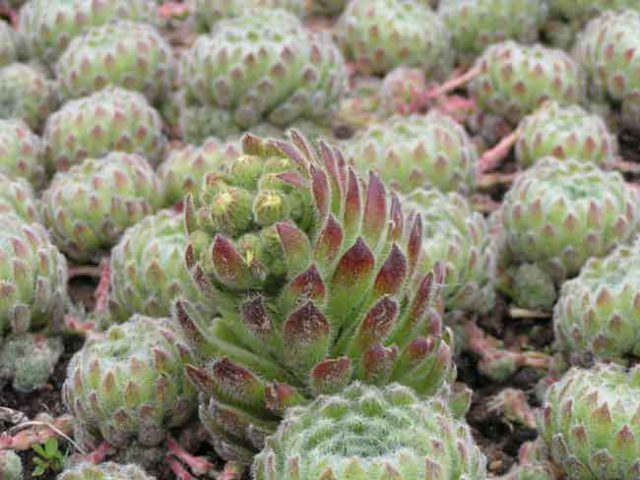 Var. borisii
Var. borisii
S. grandiflorum (M. large-flowered)
Spiny fleshy leafy rosettes with a diameter of 2.5 cm form loose clumps with numerous daughter rosettes on creeping shoots. Large yellow flowers bloom on peduncles up to 20 cm high. The species grows best on acidic soils. The height and diameter of the plant is 5x30 cm.
 Spiky fleshy leafy rosettes
Spiky fleshy leafy rosettes
S. marmoreum (M. marble)
Variable species with spiky tips of dark green leaves forming rosettes up to 6 cm in diameter. Red flowers sit on stems 20 cm high.The height and diameter of the plant is 5x30 cm.
 View with spiky-tipped dark green leaves
View with spiky-tipped dark green leaves
The variety forms denser rosettes of brownish leaves that turn red in autumn.
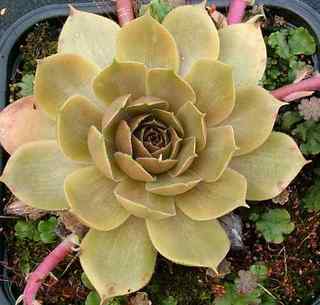 "Brunneifolium"
"Brunneifolium"
S. montanum (M. mountain)
Fleshy semi-open bright green rosettes with a diameter of 7.5 cm give long side shoots with daughter rosettes and form wide loose mats of greenery. Maroon flowers sit on peduncles 10 cm high.The height and diameter of the plant is 6x36 cm.
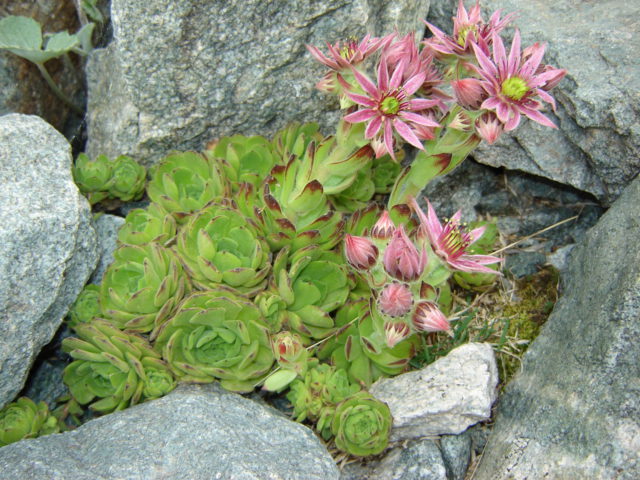 Fleshy semi-open bright green rosettes
Fleshy semi-open bright green rosettes
The subspecies forms smaller rosettes (up to 5 cm in diameter) with reddish-brown leaf tips.
 Small sockets
Small sockets
Pittonii (M. Pitton)
Grayish-green pubescent rosettes up to 5 cm in diameter form rapidly growing clumps. Light yellow flowers sit on peduncles 12.5 cm high. The plant is not hardy enough. The height and diameter of the plant is 5x15 cm.
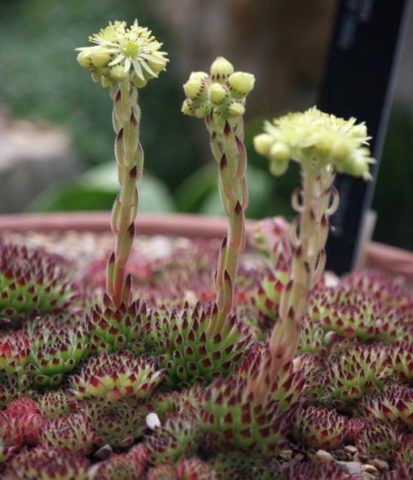 Grayish green pubescent rosettes
Grayish green pubescent rosettes
Tectorium (M. roofing)
Variable appearance with rosettes up to 18 cm in diameter, forming wide curtains. Attractive pink-red or purple flowers are collected in one-sided inflorescences and bloom at the tops of peduncles up to 50 cm high.The height and diameter of the plant is 7.5x30 cm.
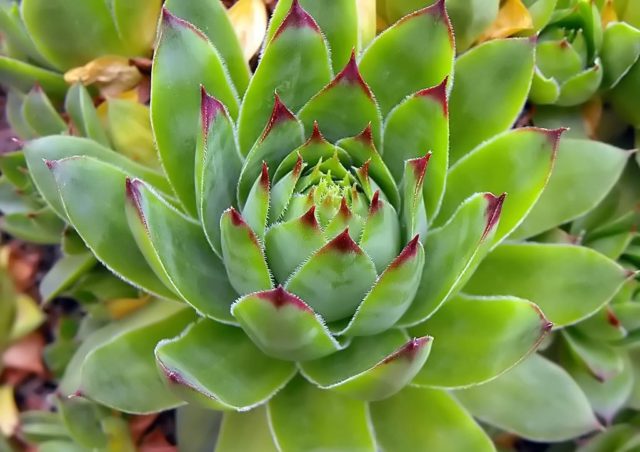 Attractive pink-red or purple flowers
Attractive pink-red or purple flowers
The subspecies forms smaller rosettes and dense curtains.
 Dense curtains
Dense curtains
The variety is distinguished by a rich purple-violet color of the leaves.
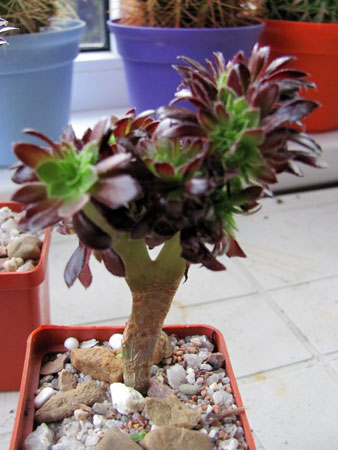 "Atropurpureum"
"Atropurpureum"
The bright green leaves have purple tips.
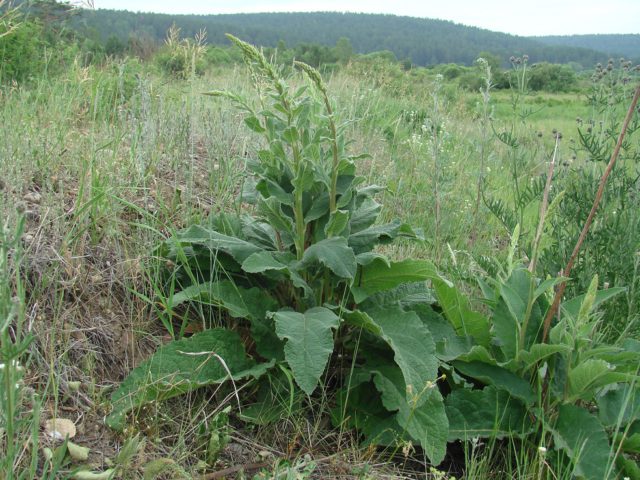 "Nigrum"
"Nigrum"
The tips of the leaves turn orange in autumn.
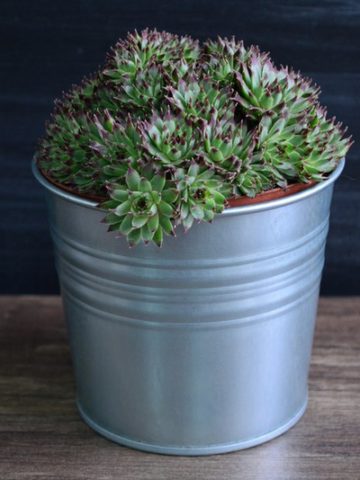 "Sunset"
"Sunset"
S. thompsonianum (M. Thompson)
Small spherical rosettes with a diameter of 2 cm turn red in the bright sun and form dense curtains. Pink and yellow flowers sit on peduncles 7.5 cm high. Low winter hardiness. The height and diameter of the plant is 2.2x15 cm.
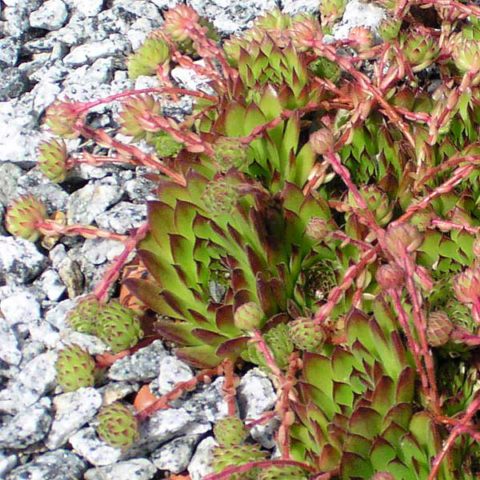 S. thompsonianum
S. thompsonianum
These plants are grown exclusively for the attractive coloration of leaf rosettes.
The variety has green-crimson leaves with pubescent tips.
 Green-crimson leaves
Green-crimson leaves
Green leaves with crimson tips.
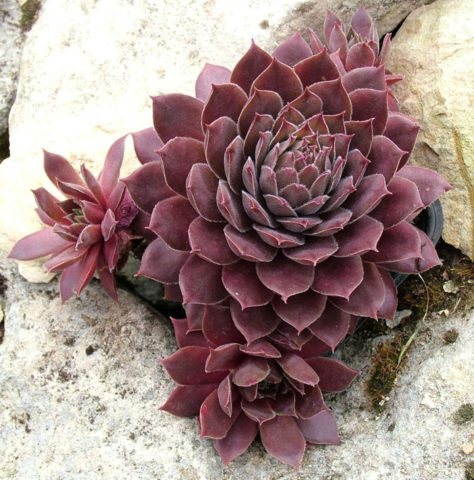 "Blood Tip"
"Blood Tip"
The variety has green leaves with a reddish tint.
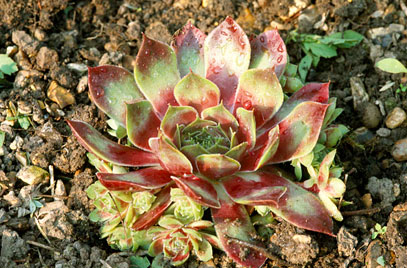 "Commander Hay"
"Commander Hay"
Rosettes dark red with silvery hairs.
 Rosettes dark red
Rosettes dark red
Plants of the variety are pubescent, light green, and in summer with a burgundy tint.
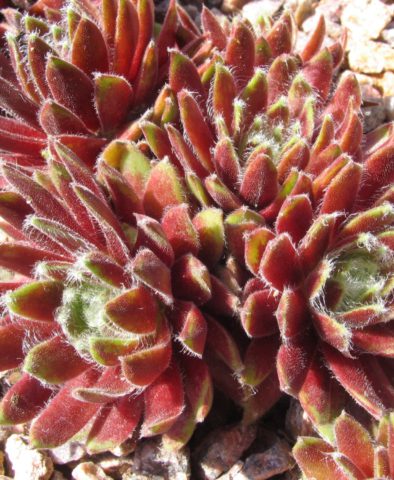 Pubescent plants
Pubescent plants
The variety is similar to “Jubilee” but lacks the burgundy hue.
 "King George"
"King George"
Leaves are rich reddish-brown color.
"Mahogany"
A variety with a pink tint.
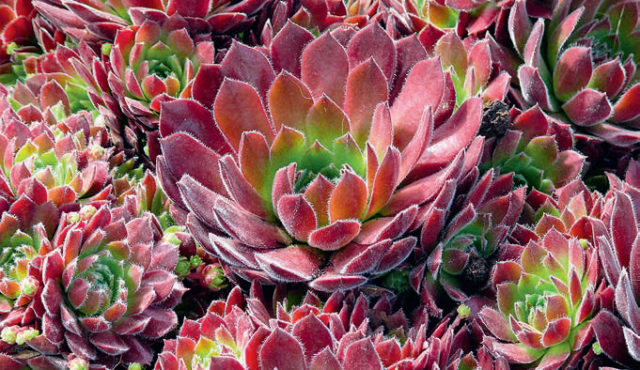 "Rosie"
"Rosie"
The leaves are dark red.
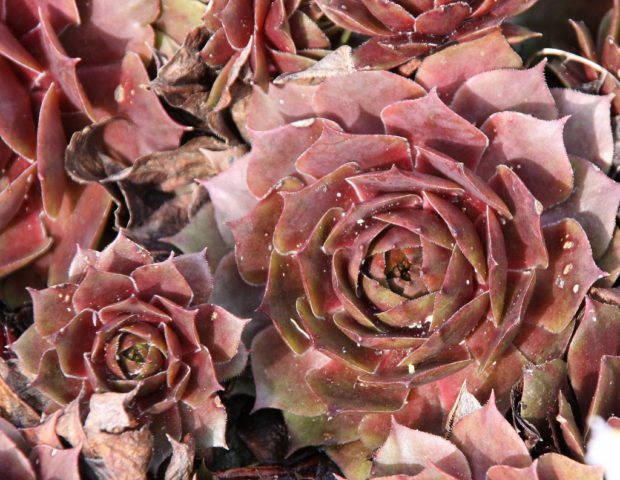 "Royal Ruby"
"Royal Ruby"
Reproduction was young
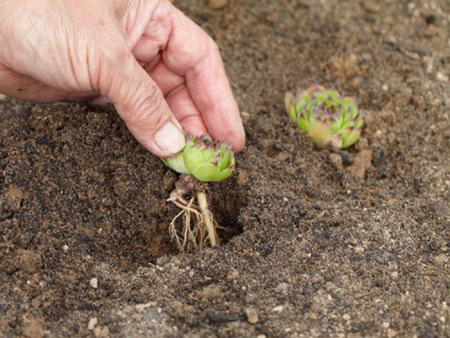
Propagation by cuttings
This method is not suitable for rejuvenating, since the structure of the flower is such that it is impossible to cut off cuttings for rooting.
Children
This method is the most accessible and simple. At the same time, the process of reproduction by children also occurs independently, without the additional help of a gardener. However, if you want to fill the resulting empty space or speed up the breeding process, it is better to make some effort.
First you need to choose a sunny place. Then you need to loosen the soil on the site, separate the rosette with a mustache from the mother plant and plant it, while the mustache must be slightly deepened into the ground. After planting, water the soil. Thus, you can grow a real carpet from the young.
A mustache is necessary for a small outlet for the formation of a main root in the future. If you cut the rosette without the tendril, rooting will be much slower.
Features of home care
Since the plant is very unpretentious, it will not be difficult to grow it in the house. Rejuvenated grows well in the dry air of apartments and does not require frequent watering. And since there is a huge selection of different varieties, you can create a small garden on the windowsill.
The soil
In order to start growing juveniles, you will need loose and sandy soil, like for cacti. It is better to choose a container that is wide and roomy, so as not to transplant the plant once again. Good drainage must be ensured. To make the most suitable substrate you will need:
- shop soil for cacti (or succulents)
- coarse sand
- small chips of red brick or gravel
- coal
- expanded clay or other stones for drainage
To the earth and sand (1: 1 ratio), add a little brick chips, or gravel, and a small amount of fine coal. Mix the mixture well. Pour drainage stones on the bottom of the pot to a height of about 2-3 cm, and then - the prepared soil.
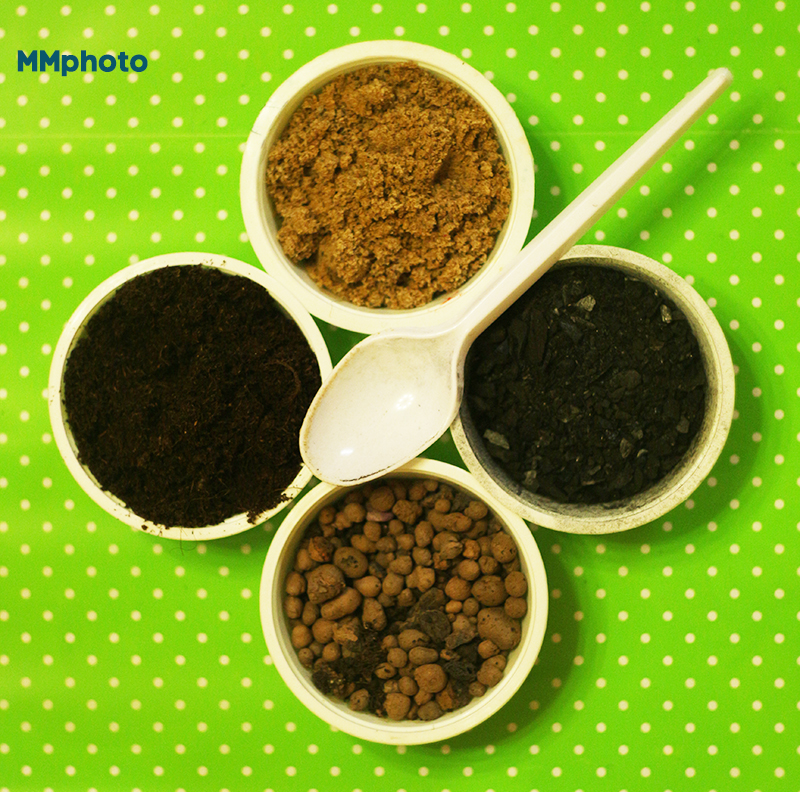
Watering
The plant does not need frequent watering, since all the necessary and useful substances, including moisture, accumulate in the leaves.
- In the warm season, it is enough to water the plant once every two weeks. In winter, however, watering should be reduced to twice a month.
- If there is too much moisture to the plant, then this is immediately noticeable by the lower leaves, which begin to wither and dry out.
Lighting
It is better to grow sun-loving plants in an apartment on a windowsill on the south side. In winter, additional lighting with photo lamps is required. After the winter period, you need to gradually expose the young to the sun, in order to avoid leaf burns.
Temperature
- Temperature readings will not harm the young.
- High temperature readings and slight frosts will not cause inconvenience to the plant.
- Already from the beginning of spring, it is better to put the young on the windowsill, where it will be much more comfortable.
- Another important factor of good growth - the room in which it grows rejuvenated, needs frequent ventilation and fresh air.
Transfer
It is required to transplant new plants purchased in the store, and then, as they grow, once every 2-3 years. For transplanting you will need: a small pot, drainage, prepared substrate. It is best to transplant by transshipment, so as not to damage the already formed root system of the plant. Place a drainage layer on the bottom of the pot. Then set up the plant and cover the sides with soil. It is recommended to put a layer of sand on top, and cover it with coarse decorative sand or fine expanded clay.
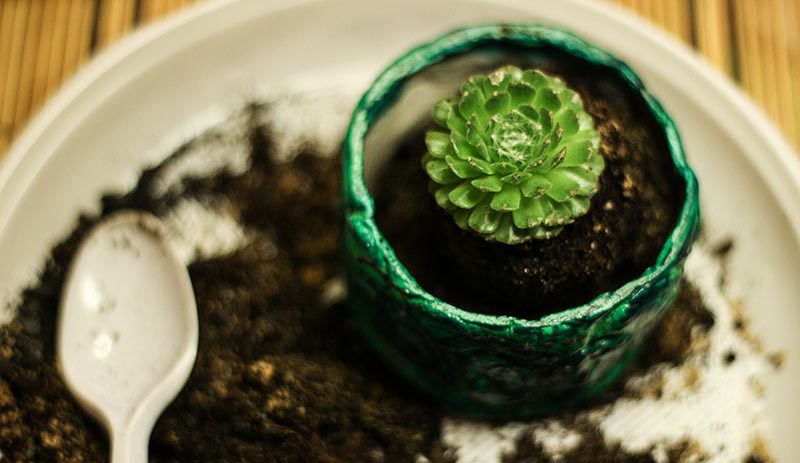
Reproduction
Carried out by seeds (very rarely) and vegetatively (daughter rosettes). The daughter rosette is genetically identical to the mother rosette, it appears from the axils of adult plants, and as they grow, their connection becomes weaker, and then it completely breaks off, and the plant becomes independent. The rosette can be planted even if it has not yet developed roots. To do this, it is enough to put the shoot on the ground and keep it moist. Roots germinate very quickly under these conditions.

Diseases and pests
- Probably the only thing that can ruin a plant grown at home is an excessive passion for watering. The plant begins to rot from excess moisture, thereby dying, since this process is practically irreversible. If brown or black spots appear on the plant, this is a start for excitement. It is urgent to reduce watering and loosen the soil so that it dries out faster and does not die young.
- Aphid. Determining this disease will not be difficult. Small greenish insects begin to spread over the entire flower. If aphids appear, the plant stops receiving useful compounds, the leaves turn yellow. What to do? If the aphid has spread widely throughout the plant, then the affected areas of the flower should be cut off, the remains should be washed with laundry soap. However, if a small part of the plant is affected by aphids, you just need to rinse the flower with soapy water. Such liquid should not get into the ground of the flower.
The appearance and description of the plant

Large fleshy stellate leaves are the main sign of rejuvenation
Rejuvenated is a perennial fleshy herb with pubescent glandular hairs (sometimes there are absolutely naked varieties). The plant forms very dense rosettes, consisting of many leaves. The leaves themselves are quite thick, succulent. Their shape is usually ovoid, less often oblong.
The flowers are fused at the base of the sepals and petals, numbering from 8 to 20. The petals are slightly longer than the sepals, they have a star-like shape. There are always twice as many stamens as petals (from 16 to 40). Flowers are always collected in panicle type inflorescences. Blooms rejuvenated in early or mid-summer.
The root system is dense, consisting of several rhizomes connected to each other by underground side shoots - stolons. Thanks to the stolons growing in different directions, the young is able to cover large areas.
The species diversity was very large. More than 500 species of this plant have been described, differing from each other in the shape of leaves, rosettes, and flowers. Each type has its own unique shade. Of these species, about 50 have perfectly adapted to life in the climatic conditions of a temperate climate in the CIS.
The species diversity of the young is shown in the photo below:

Species diversity rejuvenated
But, of course, most types of stone roses are indoor ornamental plants. They are thermophilic and in our climate can be grown exclusively at home.
Some types of indoor stone roses can be grown in the open field, but they are significantly smaller, in addition, with too severe winters, they can freeze out. Therefore, when choosing plants for landscaping a garden, you should know exactly their cultivation characteristics.
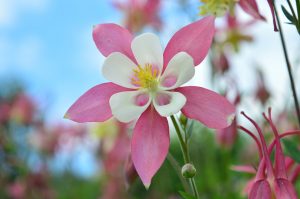
Aquilegia: the 25 most common species, the rules of planting, care and reproduction (70+ Photos & Videos) + Reviews
Use in landscape design
The varied color of varieties and hybrids allows designers to create amazing monoclumba by combining different representatives. The best landscape for them is huge stone boulders. Harmonious and extraordinary carpets and ensembles are obtained from the young. They are actively used in:
- rock gardens;
- rockeries;
- discounts;
- stone gardens;
- narrow flower beds.
There is no better element for creating a mini-garden on a large stone lying on its side or on a driftwood than a succulent plant.The stone is an integral partner of the rejuvenated. It is also planted in curly containers and pots. In addition to the standard landing site, such as the edge of garden paths, the roofs of various buildings and structures can be used.
Combination with other plants

The ideal partners for a stone rose are:
- arabis;
- saxifrage;
- sedum.
By successfully combining them, you can create a colorful, bright carpet. An equally spectacular element of garden design is the combination of many varieties of stone roses.
Wintering was young
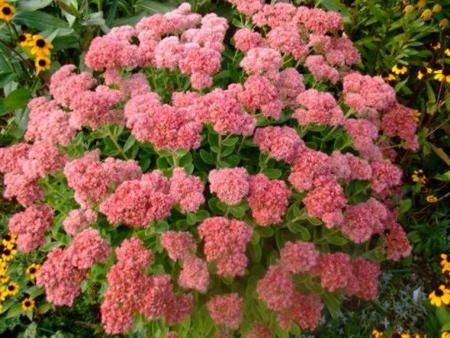
Given the plant's phenomenal endurance, it is not at all necessary to cover it for the winter. Moreover, this can cause the death of the young - in the spring, during the thaw period, the flower vomits out under a dense shelter.
If in the spring you find that some of the stems of the plant have dried up, remove them and replace them with young rosettes. Even if you don’t do this, the youth will grow itself into a lush carpet.
If the young are for the first time to overwinter in the garden under the snow, you can slightly cover the plants with spruce branches, you also need to protect expensive flower varieties from the cold. Gardeners recommend protecting the most valuable varieties of rejuvenated with a plastic bottle. In the spring, some plant varieties change their color and become a little brighter, these are natural changes and are not dangerous for the young.
Planting mallow in open ground
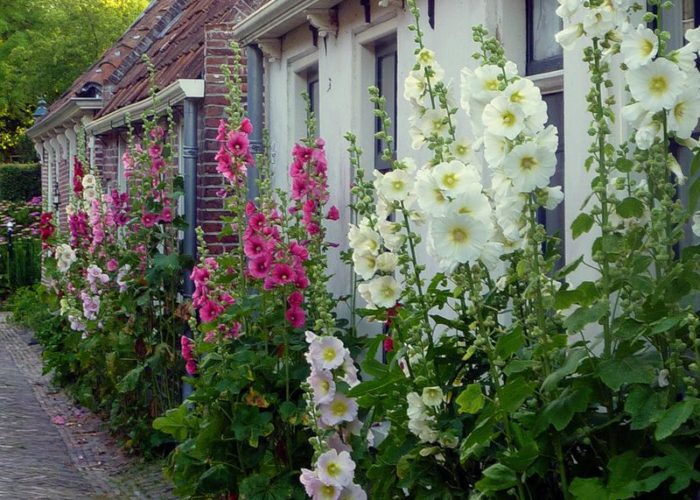
Suitable soil
For mallow, it is necessary to choose a well-lit area. In partial shade, it will also grow, but its color will not be so saturated, and the shoots will be relatively low. It is better to choose loamy soil, well-drained, rich in humus. For planting, you must choose a site located on a hill, since if melt water stagnates in the soil, then rot may appear on the root system of the plants. It is best if the site is protected from wind gusts and drafts. It is recommended to plant these flowers near the fence, in this case it will be possible to tie long stems directly to it. If the soil is not rich in nutrients, then fertilization will be required. To do this, you will need to sprinkle the area with a layer of mulch (humus).
Open ground planting rules
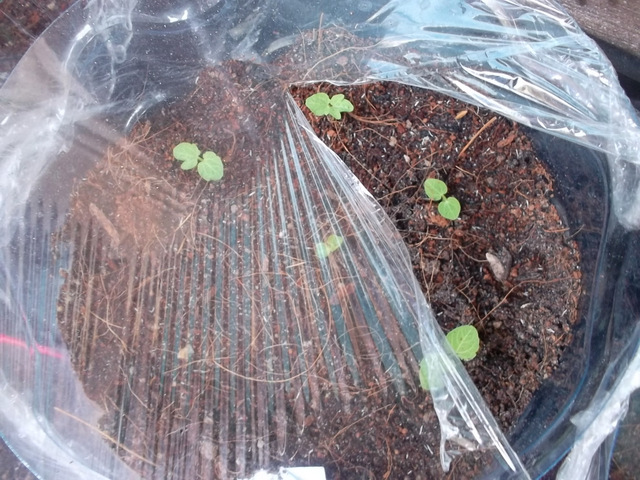
Seedlings of annual varieties should be transplanted into open soil in the middle of May. It should be remembered that seedlings of perennial or biennial varieties must be planted in the garden only in August or September. Seeds of biennials and perennials can be sown directly into open soil. This should be done in the spring from April to May, when frosts have passed. To do this, shallow (about 3 centimeters) small pits must be made in the ground and 2 or 3 seeds must be put in each of them. The distance between the holes can vary from 25 to 50 centimeters, while it depends on the type of plant. The hole is filled with soil, lightly tamped and watered with a small amount of water. In the event that frosts are expected, the bed must be covered with a covering material, in this case you will be able to protect the seedlings from freezing. If the weather is warm, you will see the first seedlings after half a month. After the appearance of the third or fourth leaf, it is necessary to thin out the crops. So, one of the strongest seedlings should remain in the hole.
Care for juveniles in the open field after planting
The agricultural technology of these plants is very simple. They are not afraid of spring frosts, hot summer sun and drought; they do well without watering and fertilizers, and are not affected by pests and diseases. Even an inexperienced gardener is quite capable of creating all the necessary growing conditions for rejuvenating.
Location. The plant is light-requiring, does not tolerate shading, including weeds and leaf litter. In the shade and partial shade, the rejuvenation will slowly develop, the leaves will become dull, which will affect the decorative effect of the flower. The rejuvenated grows well and blooms in a sunny place in a rockery or on an alpine hill.
The soil.It prefers any soil, except moist, with a neutral or slightly alkaline reaction. Feels good on light, loose, drained soils. Coarse sand, expanded clay, granite screenings are added to the soil. Large leafy rosettes are formed in the area oversaturated with nutrients, but the color is not very bright.
Transfer. It is not often required, usually once every 3 years, when the leaf rosettes begin to shrink and curl. This work should be done in early autumn on a fine day. This culture easily tolerates transplanting and takes root quickly.
Watering. Frequent watering is not necessary for the plant, it is enough to irrigate it on hot days
It is important to take into account that stagnant moisture in the soil will negatively affect the state of the succulent and can lead to its decay. Reacts especially hard to waterlogging rejuvenated cobweb
All species tolerate drought well.
Preparation for wintering. An adult plant is winter-hardy, does not require shelter. It is recommended to cover young individuals with spruce branches or dense material so that they are not damaged if the winter is snowless and frosty.
Another care. Weeding, loosening after watering, removing faded inflorescences along with dead rosettes.
Rejuvenated: planting and care at home
The plant is successfully cultivated at home. There are many unpretentious hybrids with decorative qualities that look great in any interior.
Reproduction

Rejuvenated are propagated most often in two ways:
- baby outlets;
- seeds.
Around an adult plant, many offshoots appear, which quickly take root and form a dense cover if they are not planted in time.
Novice gardeners who want to grow a beautiful flower often choose a large outlet when buying - they want to get as many children of the variety they like. This is mistake. It is necessary to plant small daughter outlets, since adult large specimens often bloom and die after transplantation - the rejuvenated blooms once in a lifetime.
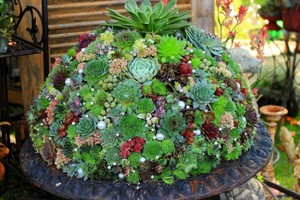
to get new varieties
Sometimes seeds of popular species are purchased in nurseries where they are engaged in plant growing on an industrial scale. Unfortunately, such seeds do not always fully retain the varietal qualities of flowers.
Sowing seeds rejuvenated, growing and caring for seedlings
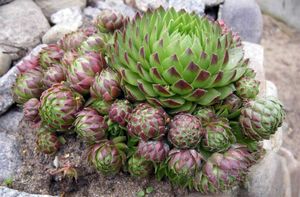
any time of the year
You will need:
- Shallow container with drainage holes.
- Pallet.
- Soil substrate (you can use ready-made soil for cacti and succulents or a mixture of turf soil with coarse sand and activated carbon).
- Sprinkler for soil moisture.
The soil mixture is poured into a container, slightly moistened with a sprinkler and placed on a pallet. The seeds are placed on the soil. Do not drip or sprinkle on top, but only slightly press down with your fingers. Cover the planting with glass or transparent film.

necessary
Seedlings appear in 3–8 weeks. They are very small and delicate, they need good lighting, especially in the morning, and ventilation. After 30 days, they are dived into the prepared moist soil at a distance of 4–6 cm from each other and left without watering for 2 days. The plant is planted in a permanent place after a few months, when it grows up. It is better to do this in spring or early summer. An adult stone rose will become only after 2 years.
How to care for a stone rose
Rejuvenated - the plant is unpretentious and caring for it does not require much effort. If you create the right conditions for a stone rose, planting and caring will take very little time.
To maintain a dense outlet and bright color, it is necessary to maintain optimal lighting, air humidity and temperature in the room.
What matters are:
- Location. The plant needs bright light. Best of all, rejuvenated feels on the windowsill of a window facing east or southeast. For other accommodation options in the apartment, artificial lighting should be provided, especially in the morning.The young is not afraid of drafts, but it must be protected from the frosty air in winter.
- Temperature. In summer, the plant feels comfortable at a temperature of 18-25 ° C. It tolerates heat well. In winter, a suitable temperature is 12–16 ° C.
- Lighting. Ideal: bright sunlight in the morning, light scattering and partial shade from 12 to 16 and sufficient illumination from 17 to 21 in the summer. In winter, if it is not possible to provide a cool wintering, it is necessary to highlight the plant after 17 hours, and on cloudy days also in the morning.
- Air humidity. With high humidity, the leaves will fade, and the cobweb varieties can rot. Dry air does not harm the plant, it is not necessary to spray it even in the heat.
If all conditions are met, care is as follows:
- Dust cleaning. Once every 2 weeks, the plant is cleaned of impurities with a stream of cool air or wiped with a slightly damp cloth.
- Watering. It is necessary to water the plant rarely and not abundantly. It is enough to moisten the soil two or three days after it is completely dry. You need to water the rejuvenated around the outlet, without getting on the leaves. When several plants are densely planted in a wide container, it is convenient to use a medical syringe for watering. Usually in the summer the young are watered once every 1.5–2 weeks, and in the winter - once every 1.5–2 months.
- Transfer. Adult plants are transplanted into fresh soil once every 3 years. At the same time, they receive enough nutrients from the soil and do not need additional fertilizing. Children, if they do not want to get a dense flower group, are planted almost immediately so that they do not deplete the mother plant.


